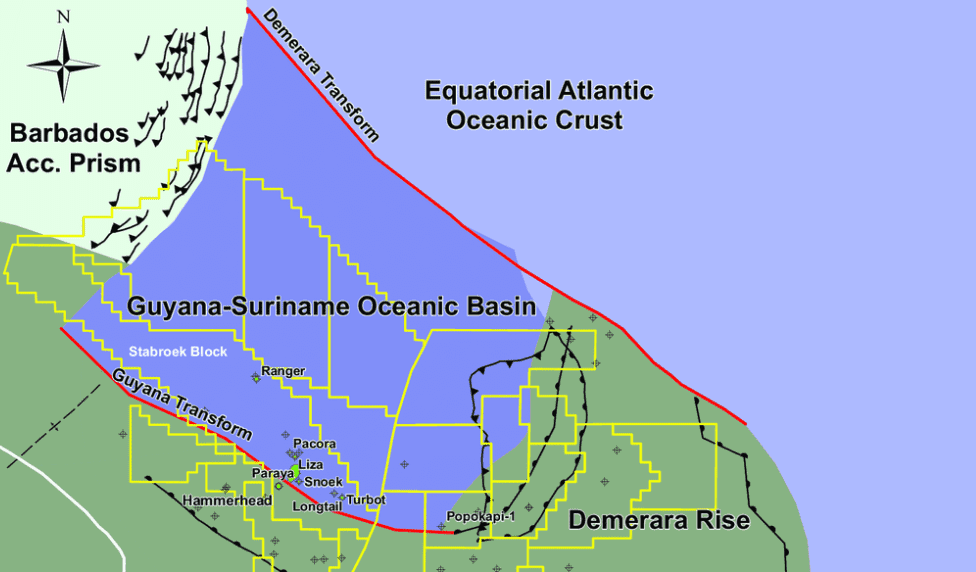Updated August 28, 2021
The Berbice River in Guyana, during the early period of the planet’s formation helped “drain” the northern part of South America to form a 1,000 metre deep canyon believed to be the basis of the stratigraphic traps that will later become known as the Guyana-Suriname Basin which has now becoming one of the most attractive destinations for exploration.
This is the professional assessment of Ken Nibbelink, Dick Boyce, Mosab Nasser and John Boyce of JHI Associates, Inc. (BVI) who made a presentation at the Virtual Research Symposium on Southeast Caribbean and Guiana Basins in September 2020. The title of their presentation is ‘Guyana-Suriname Deep Water Hydrocarbon System, Three Rivers and Two Source Rocks’. JHI’s main asset is a 17.5% carried interest in the Canje Block offshore Guyana covering over 4,800 square kilometres.
Yielding 22 commercial discoveries at the Stabroek Block totaling over 9 billion barrels of oil equivalent resources, and 5 discoveries offshore Suriname exceeding an estimated 6 billion barrels, the Guyana-Suriname Basin has indeed proven prolific with companies ramping up their exploration and production activities in the area. Six other discoveries have also been made offshore Guyana, outside of Stabroek – Joe and Jethro (Orinduik block), Carapa (Kanuku block), Tanager (Kaieteur block) and Bulletwood and Jabillo (Canje block).
“The Guyana-Suriname Basin deep water hydrocarbon system can be summarized by the interaction between three river systems, Aptian Demerara, Upper Cretaceous Berbice and Miocene/Pliocene Amazon and two source rocks…” said Ken Nibbelink who made the presentation on behalf of the group.
Guyana, Suriname will eat up more deep water investments as majors double down
He said that the basin is located at the southern end of the North Atlantic rift where thick Lower Cretaceous/Jurassic carbonate platforms rim the deep water Jurassic oceanic crust and the massive Aptian, Demerara River system flowed northwest into Suriname between Africa and South America.
“The Berbice River during the Upper Cretaceous was draining the entire northern part of South America and formed a 1000m deep canyon across the shelf that delivered over 1 second of sediment to the deep water, including the second cycle Campanian/Maastrichtian reservoirs from a Pre-Cambrian Quartzite provenance,” Nibbelink said.
He explained that while the Berbice overburden matured the first source rock, the second source rock, known locally as the Canje Shale, was subsequently deposited across the entire deep-water portion of the Guyana-Suriname Basin. He further stated that the Berbice drainage system is captured during the Lower Tertiary and reorganized into a series of smaller river systems where sediment is stored in the fluvial, near shore and shelf environments, so the deep water basin receives very little sediment.
“The Berbice overburden [allowed] the first source rock to start generating oil, then the very low sedimentation rate [allowed] continuous oil generation from that source for 40 million years when the Campanian/Maastrichtian reservoirs are below the oil biodegradation risk and above the reservoir cementation risk. The Amazon River sediment is swept northwest by shelf currents into the Guyana-Suriname Basin…”
Scale of resources, production potential at Suriname’s Block 58 “bigger than big” says APA official
According to energy market research and intelligence firm Westwood, more oil and gas were discovered in stratigraphic traps than any other trap type in the last decade and the Guyana-Suriname basin remains one of the most prolific stratigraphic trap basins.
Westwood analyzed stratigraphic trap exploration between 2008 and 2019 in 66 basins and 113 different plays and found that 35 bnboe has been discovered in clastic stratigraphic traps since 2008.
U.S. Geological Survey may have grossly underestimated massive Guyana-Suriname basin potential
“The most prolific basins were [Guyana/Suriname], the MSGBC, the Rovuma-Rufiji and the Colville, where major new plays dominated by stratigraphic traps emerged in the period. Upper Cretaceous aged stratigraphic traps delivered 42 commercial discoveries, with a total of 9 bnbbl of oil and 39 tcf of gas, of which 7 bnbbl of the oil is in the [Guyana-Suriname] Basin and 20 tcf is in the MSGBC basin,” Westwood said.




